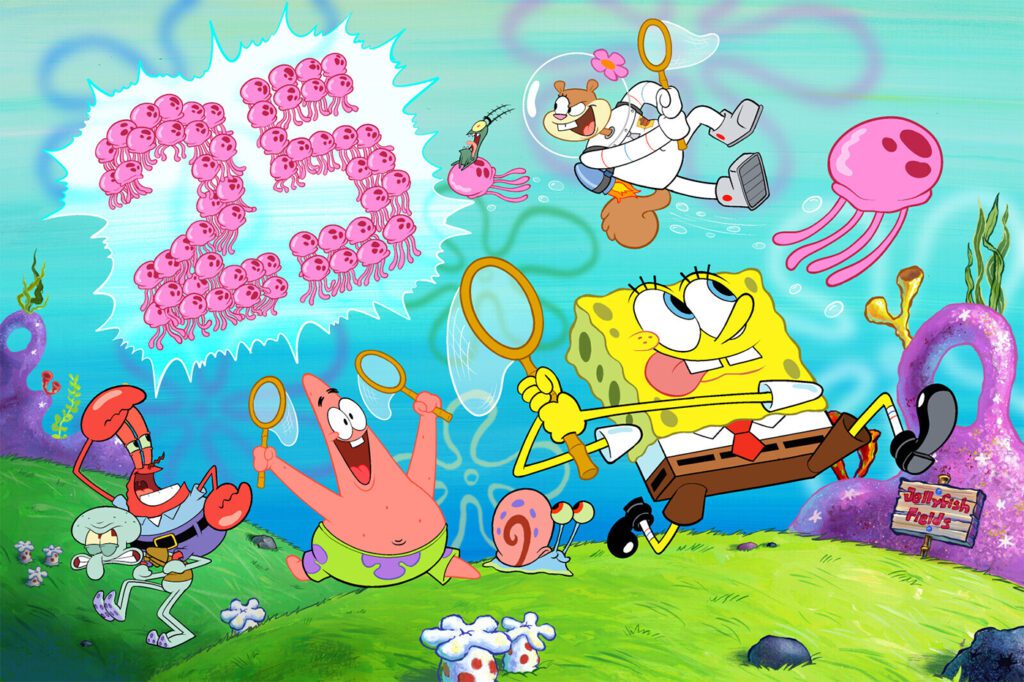Who lives in a pineapple under the sea? Whether you’re an adult or a child, you probably know the answer to that question. If you don’t, expect someone to yell out “SpongeBob SquarePants!”
For the last 25 years, the animated comedy series has been such a fixture of the pop cultural firmament that it’s easy to take it for granted. However, the idea of an animated show about a sentient sea sponge and his friends was never a guaranteed success. It’s an idea strange enough that looking back on the show’s miraculous 25-year history — and its future with a new “SpongeBob” movie about to hit theaters — raises the question: How has “SpongeBob” defied the odds to become a decades- and generation-spanning hit?
“SpongeBob” excels in almost every conceivable way as an animated production — animation, humor, stylistic boldness — but Jason Donati, an award-winning animator and teaching professor of design at Northeastern University, says the show’s long-term success goes beyond those individual qualities.
“The reason why we’re still talking about SpongeBob … is because it has, all puns intended, these tentacles that reach different audiences at different times in their lives and touch upon current pop culture in ways that mean something now but also mean something 10 years from now, 20 years from now and now 25 years from now,” Donati says.
The show’s multi-audience appeal goes some way toward explaining its long-term success. “SpongeBob” now spans across the original television show, four feature films, two spinoffs, a Broadway musical and a Super Bowl appearance. Now in its 15th season, the show is as culturally relevant as it’s ever been. It’s distributed in more than 170 countries, translated in more than 30 languages and averages more than 100 million viewers every quarter, according to Nickelodeon.
In the current streaming era when animated productions are increasingly getting scrapped or removed from platforms altogether, a long-running program like “SpongeBob” is something of a rarity.
There is a quality to the humor and surreal style in “SpongeBob,” with its sly references to other media and quick sight gags that go over the heads of most children, that has allowed it to bridge the gap between generations, Donati explains. It’s a quality often associated with Pixar’s emotionally rich animated films, but Donati says the creators of “SpongeBob” “take it further than the Pixar films do.”

“Now, it’s just what you do by the way,” Donati says. “It’s just the standard: You talk to multiple audiences of animation unless it’s really programmed at super young kids, like Disney Junior, or adult animation.”
“SpongeBob” has now been running long enough to hit what Donati calls the “generational curve.” Millennials who grew up watching SpongeBob and his underwater friends get into animated misadventures are now sharing the show with their children. As they rewatch the show, parents see the show in a new light, while their children get to enjoy it the way their parents did when they were younger.
Internet memes have also been crucial to the show’s multi-generational lifespan. Go anywhere on the internet, especially on social media, and you’ll quickly encounter at least one SpongeBob meme.






The intense meme-ability of the show is partially coincidental. The audience that grew up on the show is part of the initial generation of meme creators on the internet. Donati says it’s hard to overstate how much memes have helped prolong the cultural lifespan of “SpongeBob.”
“‘SpongeBob’ is so engrained in that generation’s mindset that it comes with all this preset baggage, so I can get right to my funny point that I want to make,” Donati says. “It’s hard to do with other IPs.”
Beyond its impact on audiences, “SpongeBob” was a “critical bridge” for the animation industry, Donati says. It arrived at a time when animated productions were shifting toward 3D animation and away from the more traditional 2D animation.
Creator Stephen Hillenburg’s original commitment to 2D and the incredible early success of the show staked a flag in the ground for 2D animation’s future in the industry.
“I think ‘SpongeBob’ is the reason we still have things like Cartoon Network, ‘Adventure Time,’ ‘Rick & Morty,’” Donati says. “Full stop, everything goes 3D if it weren’t for ‘SpongeBob.’”
However, much of the show’s success also belongs to its titular character. Conceived by creator Stephen Hillenburg, SpongeBob is a riff on one of the oldest comedic archetypes in Western history.
“SpongeBob is the naif: extremely innocent, and everything manages to be OK for him in the end because he’s so guileless,” Tom Kenny, the voice of SpongeBob, told The Guardian in 2016.
Characters like SpongeBob’s best friend Patrick the starfish, his cynical frenemy Squidward and greedy boss Mr. Krabs all fit into similarly familiar archetypes. But SpongeBob, with his boundless optimism and constant need to include everyone in his circle of friends, is “universal in a way that very few characters are,” Donati says.
“There’s now a generation that would recognize SpongeBob at a higher rate than Mickey Mouse,” Donati says. “‘SpongeBob’ continues to provide entertainment, have that slap sticky humor but that lovable innocence that generation after generation seems to connect with. I don’t see that stopping.”

